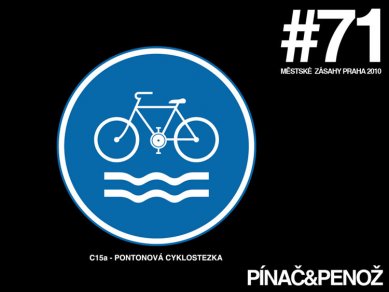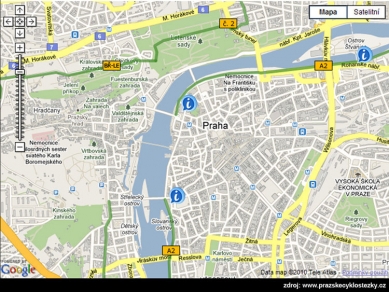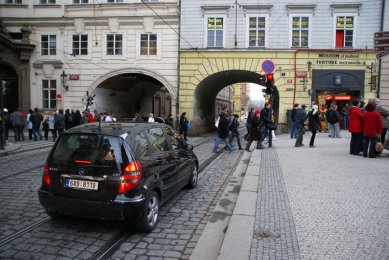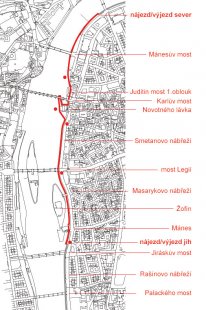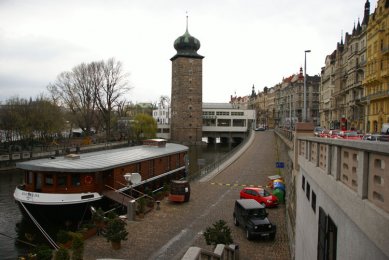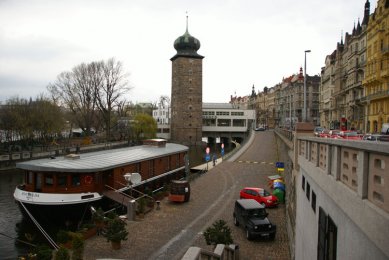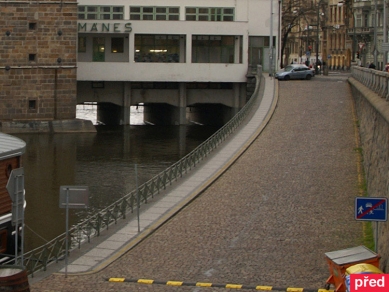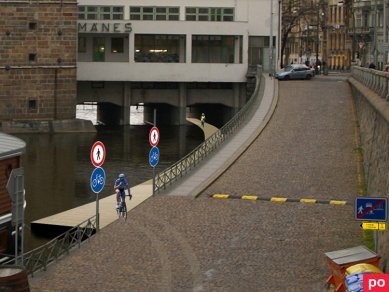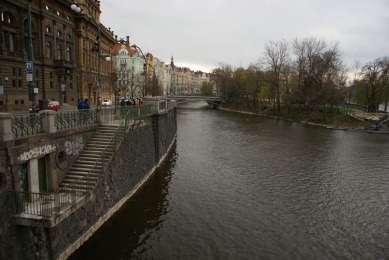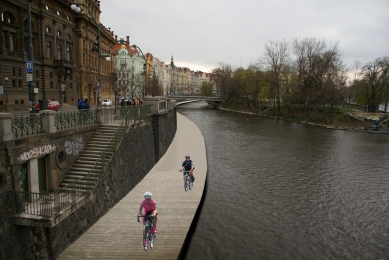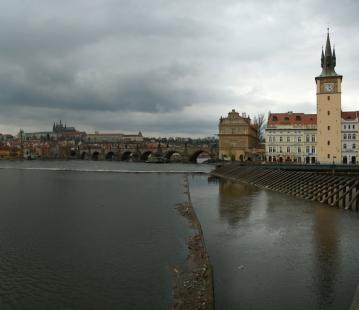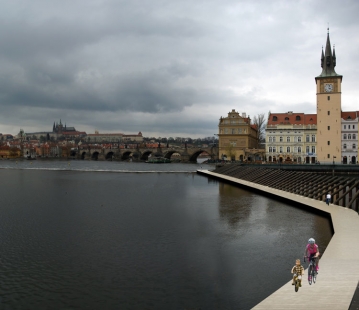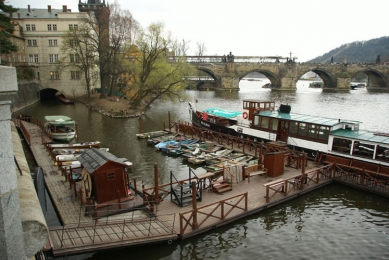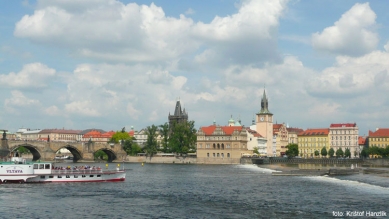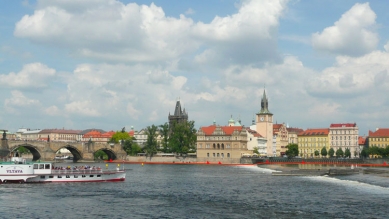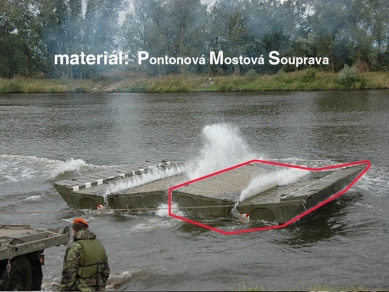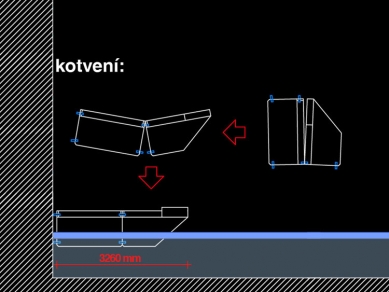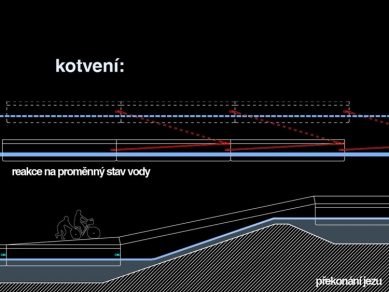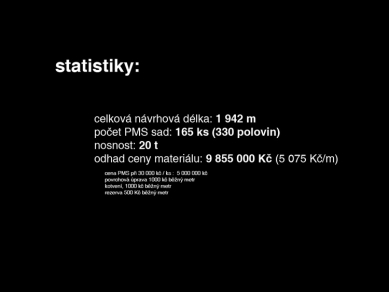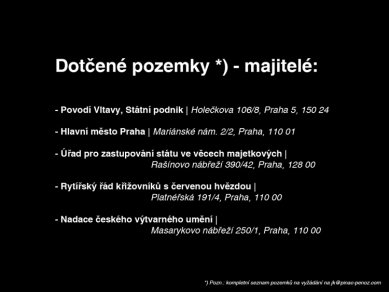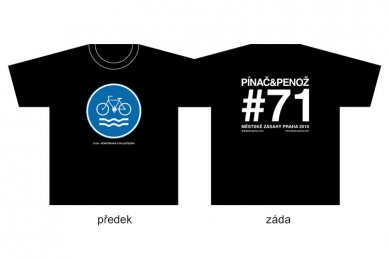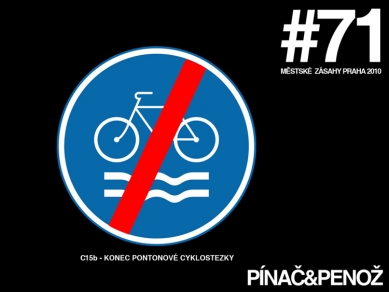
C15a - pontoon bicycle bridge

Notes:
1) Flood protection:
There is a regulation/measure that when a certain water flow value in the Vltava River is reached – roughly when the first flood hazard level changes to the second – all boats, pontoons, and docks must be cleared from the Vltava's stream and towed to protected moorings (Císařská louka, Holešovický přístav) within a time frame of minutes to a maximum of a few hours. This is to prevent the danger where a floating object can get stuck and damage property either mechanically, or by locally agitating the water which then causes destruction.
General solution A: towing the entire object in parts to protected moorings
General solution B: disassembly and removal to the bank (simultaneous use as a protective
flood barrier)
The proposed material solution utilizing military pontoon bridge sets allows for the towing of the entire cycling path structure to protected moorings: The pontoon bridge set is a comprehensive engineering system, equipped with towing boats for the construction/dismantling of the bridge – always one boat handles one segment (convoy) – approx. 53 m. These boats can also be used for the cycling path. The overall suitability of the PMS for the cycling path can certainly be debated. It would surely be an object of subsequent detailed technical solutions.
2) User safety – prevention against falling into the water:
I start from the fact that the Prague waterfronts are not equipped with railings, except for some particularly exposed areas. This means that a certain level of public responsibility is expected. I presume the same responsibility and mutual respect when using the cycling path (to politely greet oncoming cyclists and safely avoid them).
Therefore, the intention is to provide the path with only the necessary possible protection against falling, which serves the purpose, because it relates to the next point (3). I assume that a certain level of respect for potential accidents can lead to more careful and courteous behavior among users, which is inherently the most important factor for safe operation.
3) Protection of affected monuments in terms of distant views:
The body of the path itself floats just above the surface – from distant views at the edge of detectability. The only element that can visibly manifest is the prevention against falling into the water. The solution to this barrier will stem from a combination of (contradictory ?) demands for safety and the protection of monuments.
4) Physical protection of affected monuments:
Anchoring to particularly significant historical monuments can be resolved in a non-invasive way depending on the situation (e.g. Charles Bridge – the pillar can be embraced by a ring (rope) and the anchor fixed to this ring. The pillar remains unaltered). In other locations (embankment), I anticipate point anchoring into steel rings, cemented into the embankment wall.
5) Financing:
Cycling path A2 – is part of the European long-distance cycling route EV7 Nordkapp-Malta. One of its most dangerous sections is located right in the Old Town area – where cars (many cars) and trams (many trams) drive on a surface unsuitable for bicycles (cobblestones). The pontoon cycling path project addresses this issue.
Thus, there is an opportunity to fund the initiative through grants from EU funds designated for the development of (cycling) infrastructure, or even from the state transport infrastructure fund. Together with profits from merchandising ☼ – currently, "pontoon cycling path" T-shirts are on sale.
6) Facts:
The project was created as contribution no. 71 to Urban Interventions Prague 2010 (www.mestskezasahy.cz)
Author: PÍNAČ&PENOŽ – Jan Kadlas
Total length: 1942 m
Load capacity (according to tech. spec. PMS): 20 t
Estimated price per meter of material in PMS variant: 5,075 CZK*
Estimated total cost of materials: 9,855,000 CZK*
*) Relates to the body of the path - does not include items necessary for servicing and logistics. Generally, this is the first estimate based on the availability and price of key material (PMS), as can be found, for example, on Aukro.cz
1) Flood protection:
There is a regulation/measure that when a certain water flow value in the Vltava River is reached – roughly when the first flood hazard level changes to the second – all boats, pontoons, and docks must be cleared from the Vltava's stream and towed to protected moorings (Císařská louka, Holešovický přístav) within a time frame of minutes to a maximum of a few hours. This is to prevent the danger where a floating object can get stuck and damage property either mechanically, or by locally agitating the water which then causes destruction.
General solution A: towing the entire object in parts to protected moorings
General solution B: disassembly and removal to the bank (simultaneous use as a protective
flood barrier)
The proposed material solution utilizing military pontoon bridge sets allows for the towing of the entire cycling path structure to protected moorings: The pontoon bridge set is a comprehensive engineering system, equipped with towing boats for the construction/dismantling of the bridge – always one boat handles one segment (convoy) – approx. 53 m. These boats can also be used for the cycling path. The overall suitability of the PMS for the cycling path can certainly be debated. It would surely be an object of subsequent detailed technical solutions.
2) User safety – prevention against falling into the water:
I start from the fact that the Prague waterfronts are not equipped with railings, except for some particularly exposed areas. This means that a certain level of public responsibility is expected. I presume the same responsibility and mutual respect when using the cycling path (to politely greet oncoming cyclists and safely avoid them).
Therefore, the intention is to provide the path with only the necessary possible protection against falling, which serves the purpose, because it relates to the next point (3). I assume that a certain level of respect for potential accidents can lead to more careful and courteous behavior among users, which is inherently the most important factor for safe operation.
3) Protection of affected monuments in terms of distant views:
The body of the path itself floats just above the surface – from distant views at the edge of detectability. The only element that can visibly manifest is the prevention against falling into the water. The solution to this barrier will stem from a combination of (contradictory ?) demands for safety and the protection of monuments.
4) Physical protection of affected monuments:
Anchoring to particularly significant historical monuments can be resolved in a non-invasive way depending on the situation (e.g. Charles Bridge – the pillar can be embraced by a ring (rope) and the anchor fixed to this ring. The pillar remains unaltered). In other locations (embankment), I anticipate point anchoring into steel rings, cemented into the embankment wall.
5) Financing:
Cycling path A2 – is part of the European long-distance cycling route EV7 Nordkapp-Malta. One of its most dangerous sections is located right in the Old Town area – where cars (many cars) and trams (many trams) drive on a surface unsuitable for bicycles (cobblestones). The pontoon cycling path project addresses this issue.
Thus, there is an opportunity to fund the initiative through grants from EU funds designated for the development of (cycling) infrastructure, or even from the state transport infrastructure fund. Together with profits from merchandising ☼ – currently, "pontoon cycling path" T-shirts are on sale.
6) Facts:
The project was created as contribution no. 71 to Urban Interventions Prague 2010 (www.mestskezasahy.cz)
Author: PÍNAČ&PENOŽ – Jan Kadlas
Total length: 1942 m
Load capacity (according to tech. spec. PMS): 20 t
Estimated price per meter of material in PMS variant: 5,075 CZK*
Estimated total cost of materials: 9,855,000 CZK*
*) Relates to the body of the path - does not include items necessary for servicing and logistics. Generally, this is the first estimate based on the availability and price of key material (PMS), as can be found, for example, on Aukro.cz
The English translation is powered by AI tool. Switch to Czech to view the original text source.
16 comments
add comment
Subject
Author
Date
mě se to nelíbí
johny
27.05.11 12:54
iracionální, rušivý element
matěj
27.05.11 01:45
matěji, v čem je to iracionální?
jan kadlas
20.03.12 10:36
Mám lepší nápad:
robert
20.03.12 12:55
Mě se to líbí
Honza
20.03.12 12:32
show all comments



